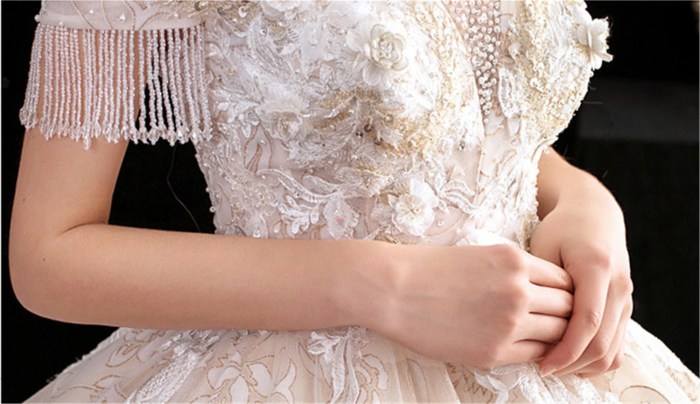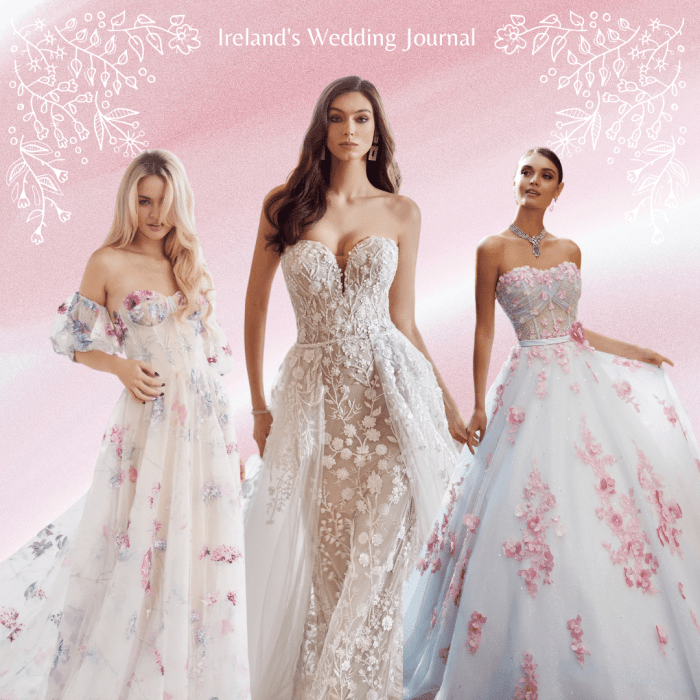Wedding Dress with Floral Embroidery A Comprehensive Guide
Design Trends in Floral Embroidery on Wedding Dresses
Wedding dress with floral embroidery – Floral embroidery continues to be a popular choice for wedding dresses, offering a delicate and romantic touch. This section explores current design trends, color palettes, motifs, and the impact of fabric choice on the final look.
Floral Embroidery Styles
Several embroidery styles contribute to the unique aesthetic of a floral wedding dress. The choice of style significantly impacts the overall texture and three-dimensionality of the design.
| Embroidery Style | Description | Visual Characteristics | Example |
|---|---|---|---|
| Appliqué | Fabric pieces are cut into floral shapes and sewn onto the dress. | Flat, defined shapes; can create a layered effect. | Delicate fabric flowers layered onto a silk bodice, creating a cascade effect. |
| 3D Embroidery | Embroidery creates a raised, textured effect, giving the flowers depth. | Flowers appear to pop from the fabric; intricate detailing. | Roses crafted with multiple layers of stitching, appearing almost sculptural. |
| Raised Embroidery | Similar to 3D, but often with a less defined, more organic look. | Soft, dimensional flowers; less structured than 3D embroidery. | Peonies embroidered with padded satin stitch, creating a plush, rounded appearance. |
| Surface Embroidery | Stitches remain on the surface of the fabric, creating a flatter effect. | Flatter, more delicate designs; often used for smaller, detailed flowers. | Tiny wildflowers embroidered with delicate chain stitch, scattered across a tulle skirt. |
Popular Color Palettes
Current trends favor soft, romantic color palettes for floral embroidery. Pastel shades and muted tones are popular, creating a delicate and ethereal look.
- Blush pink, ivory, and champagne
- Lavender, dusty rose, and sage green
- Soft blues, greens, and yellows
- Classic white with subtle hints of color
Prevalent Floral Motifs
Certain floral motifs are consistently popular in wedding dress embroidery. These motifs often reflect current trends in bridal fashion.
- Roses: A classic choice, representing love and romance.
- Peonies: Symbolizing prosperity and good fortune.
- Wildflowers: Convey a sense of bohemian charm and natural beauty.
- Floral wreaths and garlands: Create a cohesive and elegant look.
Fabric and Embroidery Interaction, Wedding dress with floral embroidery
The choice of fabric significantly influences how floral embroidery appears. Different fabrics enhance specific embroidery styles and create varied textural effects.
- Lace: Delicate lace provides a beautiful backdrop for intricate embroidery, allowing the details to shine.
- Silk: The smooth surface of silk enhances the texture of raised embroidery, creating a luxurious feel.
- Tulle: The sheerness of tulle allows light to pass through the embroidery, creating a soft, ethereal glow.
The Impact of Floral Embroidery Placement on Wedding Dress Design
Strategic placement of floral embroidery is crucial in enhancing a wedding dress’s silhouette and creating visual focal points. This section explores the interplay between embroidery placement, neckline, sleeves, and overall aesthetic.
Visual Description of Strategically Placed Embroidery
Imagine an A-line gown in ivory silk. Delicate floral embroidery, primarily featuring blush-toned roses and ivy, is concentrated along the waistline, subtly emphasizing the narrowest point of the silhouette. The embroidery then flows down the skirt in a cascading pattern, creating a sense of movement and elegance. The bodice remains relatively plain, allowing the focus to remain on the waist and skirt.
Necklines and Sleeves

Source: etsystatic.com
The neckline and sleeve styles interact significantly with embroidery placement. For example, a high neckline might feature minimal embroidery, while a strapless gown might incorporate intricate embroidery around the neckline to create a visually appealing frame for the face.
- Strapless: Embroidery around the neckline adds visual interest.
- V-neck: Embroidery can accentuate the neckline’s shape.
- High neck: Minimal embroidery can complement the neckline’s simplicity.
- Long sleeves: Embroidery can be incorporated along the sleeves for added detail.
Creating Focal Points
Embroidery placement can effectively create visual focal points. Concentrating embroidery on the bodice can draw attention to the upper body, while placing it on the skirt can highlight the lower half of the dress.
- Concentrated at the waist: Emphasizes the narrowest part of the body.
- Scattered across the skirt: Creates a whimsical, romantic feel.
- Concentrated on the bodice: Draws attention to the upper body.
- Placement along the train: Adds a dramatic touch to the back of the dress.
Materials and Techniques Used in Floral Embroidery for Wedding Dresses
The materials and techniques used in floral embroidery significantly impact the final look, durability, and overall aesthetic of the wedding dress. This section details the various threads, embroidery methods, and a step-by-step guide to a specific stitch.
Types of Threads
A variety of threads are used to create intricate floral embroidery, each with its unique properties and appearance.
- Silk thread: Offers a lustrous sheen and creates a delicate look.
- Cotton thread: Provides durability and is available in a wide range of colors.
- Metallic thread: Adds a touch of sparkle and glamour.
- Rayon thread: Offers a smooth texture and a subtle sheen.
Hand-Embroidered vs. Machine-Embroidered Designs
Hand-embroidered designs offer unparalleled intricacy and detail, while machine embroidery provides consistency and efficiency for larger areas. The choice depends on the desired level of detail and budget.
- Hand-Embroidered: Highly detailed, unique, and often more expensive.
- Machine-Embroidered: Consistent, efficient, and generally more affordable for large areas.
Satin Stitch Tutorial
The satin stitch is a fundamental embroidery stitch used to create solid, smooth areas of color, ideal for filling in petals and leaves.
- Bring the needle up from the back of the fabric at one end of the area to be filled.
- Insert the needle back down very close to the starting point.
- Bring the needle up again a short distance away, parallel to the first stitch.
- Continue stitching parallel lines, keeping the stitches close together to create a solid, smooth surface.
- Secure the thread on the back of the fabric.
Durability and Longevity
Hand-embroidered designs, when executed with high-quality threads, tend to be more durable and long-lasting than machine embroidery, particularly in areas with intricate detailing. However, modern machine embroidery techniques can also produce durable results.
The Relationship Between Floral Embroidery and Wedding Dress Styles
The style of the wedding dress significantly influences the type and placement of floral embroidery. This section explores how different dress styles are complemented by various embroidery techniques and aesthetics.
Floral Embroidery and Wedding Dress Styles
Different wedding dress styles pair well with specific types of floral embroidery. The scale, density, and style of the embroidery should complement the overall aesthetic of the dress.
- A-line: Delicate, scattered embroidery enhances the flow and simplicity of the A-line silhouette.
- Ballgown: Intricate, large-scale embroidery can add drama and opulence to a ballgown.
- Mermaid: Concentrated embroidery along the fitted bodice and flowing skirt can accentuate the curves of a mermaid gown.
Scale and Density of Embroidery
The scale and density of the embroidery impact the overall style of the dress. Smaller, less dense embroidery creates a delicate and romantic look, while larger, denser embroidery adds drama and boldness.
- Delicate embroidery: Creates a romantic and ethereal look.
- Bold embroidery: Adds drama and visual impact.
- Sparse embroidery: Allows the fabric’s texture to shine through.
- Dense embroidery: Creates a rich, textured surface.
Types of Floral Embroidery and Aesthetic
Different types of floral embroidery can significantly influence the overall aesthetic of the wedding dress. Delicate embroidery creates a soft, romantic feel, while bold embroidery conveys a more dramatic and modern aesthetic.
- Delicate: Romantic and ethereal.
- Bold: Dramatic and modern.
- Whimsical: Playful and fun.
- Classic: Elegant and timeless.
Formality and Occasion Suitability
The choice of embroidery can influence the formality and occasion suitability of the wedding dress. Intricate, large-scale embroidery is typically suited for formal weddings, while simpler embroidery might be more appropriate for less formal settings.
Illustrative Examples of Wedding Dresses with Floral Embroidery
This section provides detailed descriptions of wedding dresses featuring various floral embroidery styles, highlighting the interplay of fabric, color, and technique to create unique and memorable designs.
Detailed Description of a Wedding Dress
Imagine a wedding dress crafted from ivory silk charmeuse. The bodice features meticulously hand-embroidered climbing roses in shades of blush pink and ivory, using a combination of satin stitch and French knots to create texture and depth. The roses cascade down the skirt, gradually becoming more sparse towards the hem, creating a graceful and elegant flow. The overall effect is one of refined romance and timeless elegance.
Wedding Dress Evoking a Specific Mood
A whimsical wedding dress in soft tulle features scattered wildflowers in vibrant pastel shades, embroidered using a delicate chain stitch. The embroidery is loosely arranged, creating a carefree and playful feel. The dress embodies a sense of youthful joy and bohemian charm, perfect for a garden wedding.
Culturally Inspired Wedding Dress

Source: weddingjournalonline.com
Inspired by traditional Japanese kimono designs, a wedding dress in ivory silk crepe features large, stylized cherry blossoms embroidered in deep pink and gold metallic thread. The embroidery is densely packed, creating a rich and opulent effect. The dress evokes a sense of cultural heritage and refined sophistication.
Symbolism of Floral Motifs
A wedding dress incorporating lilies, symbolizing purity and devotion, and forget-me-nots, representing remembrance and true love, conveys a profound sense of commitment and lasting affection. The delicate embroidery, using a combination of satin stitch and seed stitch, enhances the ethereal beauty of the flowers and their symbolic meaning.
FAQ Resource: Wedding Dress With Floral Embroidery
Can I wash a wedding dress with floral embroidery?
Dry cleaning is generally recommended to preserve the embroidery. Always check the care label for specific instructions.
How much does floral embroidery add to the cost of a wedding dress?
The cost varies significantly depending on the intricacy, type of embroidery, and materials used. It can range from a modest increase to a substantial addition to the overall price.
How long does it take to create floral embroidery on a wedding dress?
The time required depends on the complexity and size of the design. Intricate hand-embroidered pieces can take weeks or even months to complete, while machine embroidery is significantly faster.
Are there any specific floral motifs that are particularly popular for wedding dresses?
Roses, peonies, and other classic blooms remain consistently popular. However, trends also incorporate more unique and symbolic flowers based on personal preferences and current fashion.

















